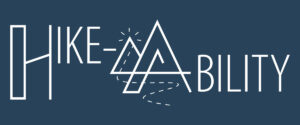Your cart is currently empty!

The “The Goldilocks Approach” to Hiking Training
—
by
Ahhh, just right!
Knowing your goals, making an appropriate plan, and applying proven techniques and principles (see “Progressive Overload” in the discussion below for example) will help you formulate a training schedule that’s just right for you.
The “Goldilocks Concept” rejects extremes in favor of a just right middle-ground. Utilizing this concept helps bring awareness to the pitfalls of under- and over-training, and encourages finding an optimal amount of training that will safely and effectively support your hiking and fitness related goals.
It’s important to recognize that either under-training or over-training can prevent you from successfully reaching your goals. Below are examples of how training (or lack thereof) can affect your hiking experience.

Time spent preparing is never wasted time — preparation results in greatness!
Walking 1-mile around your neighborhood a couple of times per week for a month, and then expecting your body to perform optimally and without issue during an 11-mile hike in the mountains during your GNP vacation just isn’t realistic. Yet each year I witness unprepared, albeit eager and determined, folks suffer through such attempts. Constantly gasping to catch your breath, experiencing early onset muscle fatigue, or encountering pain on the trail is not enjoyable. Cardio, strength, and mobility exercises are the basic elements all hikers should include in their training.
Stop doing more & start doing better!
Hiking several 15+ miles days, consecutively, with a fully loaded backpack the week leading up to an epic 4-day backpacking trip is a recipe for burnout. What a tragedy it would be to invest time, money, and effort only to end up injured or too physically drained to successfully complete your adventure! Rest, recovery, and a pre-event “training taper” are all essential components of training.


The “Progressive Overload” Principle
Progressive overload is what drives your results and is the key principle (coupled with CONSISTENCY) for making progress towards your fitness goals. It involves gradually taking on incrementally greater challenges to elicit adaptive changes and improvements in your body (aka “fitness gains”) over time.
By appropriately applying this principle, you will give your body the best opportunity for safely and successfully reaching your fitness related goals.
How to Apply Progressive Overload to Your Training:
- Progressive overload needs to be slow and gradual.
- Only implement it if you’ve been consistent with your training, and are free of injury and/or pain.
CARDIO TRAINING
Standard progression is 5-10% increase in duration (time or distance) per week.
Additional intensity factors/progression variables:
- Increase frequency (additional day of training)
- Increase incline/elevation gain
- Increase pace
- Increase pack weight (PRO TIP: If your backpack has a water hydration bladder, that’s a good way to incrementally add weight.)
It’s best to change only one intensity factor/variable at a time.
Example: (If you are performing 2 cardio sessions/training hikes per week.)
Hike #1: Shorter distance than previous week, same pack weight, but increase the incline/elevation gain.
Hike #2: Same or longer distance than previous week with slight increase in pack weight.
(For more information about cardiorespiratory training see my blog Cardiorespiratory Fitness: Aerobic Training.)
STRENGTH & STABILITY TRAINING
Master the basic form of any strength training movement first! Only incorporate progressive overload when your form allows for it; never sacrifice good form. Proper technique and optimal engagement in a basic form is a better than advancing to a progression done improperly.
Progressive Overload Variables: (DON’T change all the intensity factors/variables all at once.)
- Time-under-tension– This is a safe and effective means of adding intensity to bodyweight exercises without needing to add weight/resistance, but it can be applied to weighted exercises as well.
- Increase the number of reps
- Increase the number of sets
- Decrease the rest periods
- Add resistance/weight (mini-bands, resistance bands, dumbbells, kettlebell, weighted backpack, etc).
- Advance to a more challenging form/variation of the exercise (example: split squat to elevated split squat). Only progress if you’ve mastered proper form and technique of the basic exercise!
- Bilateral exercise to unilateral (Example: calf-raises to single-leg calf-raise). Unilateral leg movements are more challenging because your weight is now distributed on just one leg, and you have to work harder to maintain balance.
MOBILITY TRAINING
With each mobility exercise or movement you want to always work to find your greatest, pain-free (it’s okay to feel an intense stretch) end range of movement. Stay consistent with your training, and gradually advance to more challenging or advanced variations of each exercise.
(For more information about strength and stability training see my additional blogs The Importance of Strength Training, Restoring Proper Muscle Activation, The Importance of Core Stability.)
THE IMPORTANCE OF A STRUCTURED TRAINING PROGRAM
There is tremendous benefit to having a structured training program, especially one specifically designed by a fitness professional. Following a detailed and periodized training schedule will not only increase your likelihood of success, it can also minimize the chance of overtraining and exercise related injuries. Consider working with a personal trainer at your local gym, or work with me by enrolling in my HIKE-ABILITY Training Program, and start making your hiking and fitness goals a reality!
Adventure awaits… be ready for it!
Kristen, CPT and creator of the HIKE-ABILITY Training Program

Disclaimer: All information, content, and material (including associated text, videos, and links) on this website is provided in good faith and is for informational and educational purposes only. It is not intended to serve as a substitute for the consultation, diagnosis, and/or medical treatment of a qualified physician or healthcare provider. All exercise has inherent risks. Before beginning any type of exercise, please consult your health care provider.




Leave a Reply